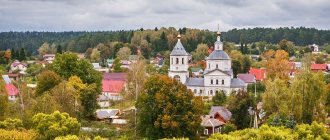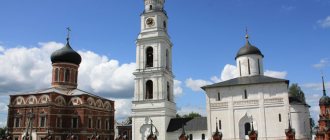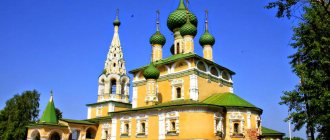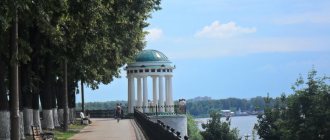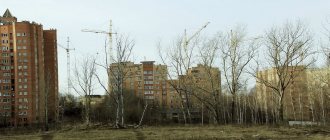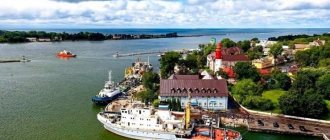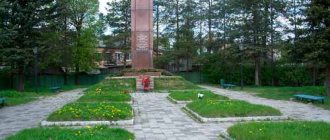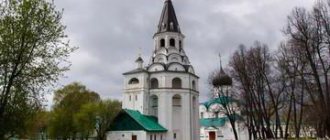Year founded: 1135
Volokolamsk celebrates City Day on
the last Saturday of July
.
In 2021,
this date is
July 31
.
In 2021, due to the pandemic, mass events in honor of the city day are canceled or may be postponed
Joseph-Volokolamsk Monastery
Volokolamsk
- a Russian city, located in the Moscow region, on the Gorodnya River (a tributary of the Lama).
On the way from Novgorod to the Ryazan and Moscow lands from the Lama River to one of the tributaries of the Ruza, ships were dragged by drag
.
Later, a settlement arose in this place to control the transit of ships. It was called Volok Lamsky, the first mentions were made in 1135
.
Being an important trading point, the city constantly became a bone of contention. In 1160, it was transformed from a settlement into a powerful stone fortress. In 1177, the city passed from the Novgorodians to Prince Yaroslav, the grandson of Yuri Dolgoruky, in 1216 Volok went to the Prince of Vladimir, in 1238 the city was completely destroyed by Batu; in 1273 it was again destroyed by the Tver prince Svyatoslav, and in 1293 by Khan Duden.
In the 13th century the city was divided into two halves. One is controlled by Novgorod, the second by Moscow. In 1332, Muscovites completely captured the city. In 1360, Volok Lamsky went to the Prince of Smolensk; the city successfully repelled the Lithuanian attack in 1371 and the invasion of the hordes of Tokhtamysh in 1382.
Cathedral of St. Nicholas the Wonderworker Then the city will change owners many times. In 1462 it became the center of the appanage Volotsk principality. In 1513 it finally became part of the Moscow principality. Volok was destroyed as one of the centers of the peasant war in 1606. In 1609 it was again devastated by the Polish troops of False Dmitry II.
In the 18th century, the city lost its commercial importance, industry did not develop, and decline set in. The main occupation of the population is flax fishing. In October 1905, Volokolamsk became part of the Markov Peasant Republic, which was liquidated only in 1906.
Volokolamsk suffered greatly during the Great Patriotic War. In October 1941, the city was occupied by German troops; in November of the same year, 7 km to the west, a rifle division stopped enemy tanks, preventing their breakthrough to Moscow. This battle is known as the “feat of Panfilov’s men.”
In 2010, by Decree of the President of Russia, Volokolamsk was awarded the title - City of Military Glory.
Modern Volokolamsk is one of the most environmentally friendly cities in the Moscow region.
Joseph-Volokolamsk Monastery
The city has preserved many
architectural monuments
. In the Resurrection Cathedral, fragments of paintings from the late 15th century have been preserved; the multi-tiered bell tower, whose height is 75 meters, is noteworthy. Also famous are the Church of the Nativity of the Virgin Mary on Vozmishche and the Church of the Intercession, St. Nicholas Cathedral and the Cathedral of St. Nicholas the Wonderworker.
In the vicinity of the city there is the ensemble of the Joseph-Volotsky Monastery. On the territory of the monastery, powerful fortress walls with hipped towers, a single-pillar refectory, and a five-domed Assumption Cathedral, made in the Moscow Baroque style, have been preserved.
The city's population is more than 22 thousand inhabitants (2013).
Day of the city
celebrated on the last weekend of July.
City `s history
Volokolamsk
Volokolamsk is a city of district subordination in the Moscow region of Russia, the administrative center of the Volokolamsk district and the urban settlement of Volokolamsk.
In 2010, by decree of the President of the Russian Federation, the city was awarded the title - City of Military Glory. Population - 20,838 people. (2017). Located on the Baltic federal highway, 98 km west of Moscow (from the Moscow Ring Road). The historical center is located on the Gorodnya River (a tributary of the Lama), 5 km north of the Volokolamsk railway station on the Moscow-Riga line.
Since 2003, after the working village of Privokzalny and the village of Porokhovo became part of Volokolamsk, the railway station and the Lama River are also located on the territory of the city.
- Geography
- Story
- Population
- Economy
- Transport
- Education
- Culture
- Religion
- Main city streets
- Attractions
- Famous people
- Twin Cities
Geography
Volokolamsk is located 100 km from the Moscow Ring Road northwest of Moscow. The area of urban land is 30–35 km². As a result of the expansion of the borders, the territory of the city increased significantly - the city stretched in the meridional direction for 14 km.
Story
Mentioned for the first time in the Suzdal Chronicle according to the Laurentian list in 1135: “Vsevolod went again to Novugorod, and Izyaslav remained on Volots”; with a localizer adjective it was mentioned in the same source, but under the year 1178: “going to Lamsky Volok.” Thus, Volokolamsk is the oldest city in the Moscow region: its age exceeds the age of Moscow by 12 years. It was called Volok Lamsky or simply Volok until the 18th century.
The name comes from the ancient Russian geographical term portage, which was already used in the Tale of Bygone Years in describing the route from the Varangians to the Greeks.
Volok Lamsky became an important trading point on the way from Novgorod to the Ryazan and Moscow lands; here the Novgorodians transported (“dragged”) ships from the Lama River, a tributary of the Shosha, which flows into the Volga in its upper reaches - to Voloshnya, a tributary of the Ruza River, which flows into the Moscow River, which in turn is a tributary of the Oka.
Having great military-strategic significance, Volok on Lama already in the second half of the 12th century became the subject of disputes between Novgorodians and Vladimir residents: in 1160 it was captured by the son of Yuri Dolgoruky, Andrei Bogolyubsky; in 1177 it was recaptured by the Novgorodians and given to Prince Yaroslav Mstislavich, the grandson of Yuri Dolgoruky; in 1216, the Vladimir prince Yaroslav Vsevolodovich began to rule it; soon expelled from here by the Novgorodians, he returned again 10 years later. In the XII-XIII centuries, Volokolamsk was ruined more than once: in 1178 - by Prince Vsevolod Yuryevich, by whom the city was completely burned; in 1238 - Batu; in 1273 - Prince of Tver Svyatoslav Yaroslavich, in 1293 - Khan Duden).
From the end of the 13th century, Volok Lamsky was under “local” control of the Novgorod Republic and Moscow; however, at the beginning of the 14th century, the Moscow governor Rodion Nestorovich, appointed to it by Ivan Kalita, expelled the Novgorodian, completely taking possession of the city. Since 1345, Fyodor Dorogobuzhsky, father-in-law of the Moscow prince Simeon the Proud, began to reign in Volokolamsk. In 1371, Volok, which was then headed by the Smolensk prince Vasily Ivanovich Berezuisky, withstood a three-day siege of the Lithuanian prince Olgerd, and in 1382 repelled an attack by Tokhtamysh’s troops. In 1393, by order of Vasily I, it was captured by the Serpukhov prince Vladimir Andreevich.
In 1398, Volok Lamsky was given to the Lithuanian prince Svidrigailo and was under his command until 1410. In 1462, the city became the center of an appanage principality (known as the Volotsk principality), which (in addition to Volokolamsk) included the cities of Ruza (in 1504 it passed to Moscow) and Rzhev; for a long time (from 1462 to 1494) it was ruled by Boris Vasilyevich), who was replaced by his son Fyodor Borisovich; under him, the Volokolamsk lands finally entered Moscow’s sphere of influence. After the death of Fyodor Borisovich, in 1513, Volokolamsk became part of the Moscow Principality; The Volokolamsk appanage principality was abolished. For some time it was part of the Staritsa principality; at the beginning of the 16th century the city was the volost center of the Moscow principality.
During the Time of Troubles it was occupied by the Poles (1606), and liberated in 1608. Besieged unsuccessfully by Sigismund (1612); A peasant war was fought in the vicinity of Volokolamsk.
In the XVI-XVII centuries. the strategic importance of the city fell; in the 18th century he found himself on the sidelines of new economic ties. However, in 1781 Volokolamsk retained its status as a district town; in 1784 the master plan for its development was approved; in 1790, the first educational institution was opened in the city - a junior public school. On seven streets and several alleys there were 240 houses, 35 trading shops, 6 inns, a tavern, 2 blacksmiths, 5 drinking houses; the number of inhabitants did not exceed 1300 people.
“Plan of the district town of Volokolamsk and its pasture lands.” Collection of materials for the study of Moscow and the Moscow province. Issue I. - Moscow, 1864
In the “List of Populated Places” of 1862, Volokolamsk is a district town of the Moscow province on the Volokolamsk tract, near the Lama and Gorodnya rivers, 783 versts from St. Petersburg, with 220 houses and 2412 residents (1143 men, 1269 women). The city had six Orthodox churches, parish and district schools, a hospital, a postal station, a factory, two factories and two fairs.
At the end of the 19th century, Volokolamsk had several industrial enterprises; the largest enterprise was the weaving factory of the Starshinov brothers, founded in 1882 in the village of Shchekino, 3 kilometers from the city; in the city itself there were two malt houses, a brewery and two brick factories. Fair trade was carried out. By the beginning of the 20th century, workers made up less than 2 percent of the total population.
Plan of Volokolamsk in 1909. "Companion on the Moscow-Vindava Railway." M.: Printing house of S. P. Yakovlev, 1909
In 1904, the Moscow-Vindava Railway approached Volokolamsk; this event, however, did little to contribute to the development of the economy of Volokolamsk, formerly a major trading center. Volokolamsk workers showed high activity in the strike movement of 1905 (in November, the largest enterprise in the city, the weaving factory of the Starshinov brothers, stopped). On October 31, the peasants of the surrounding villages entered the self-proclaimed Markov Republic (named after the village of Markovo, Volokolamsk district, the place where the republic was proclaimed). The Peasant Republic was liquidated only in July 1906.
After the February Revolution of 1917, the most significant positions in the zemstvo government of Volokolamsk were occupied by the Socialist Revolutionaries and Mensheviks. This situation remained until December 22, 1917, when the zemstvo recognized Soviet power. During 1918, almost all Volokolamsk enterprises (including the Starshinov brothers' factory) were nationalized. In 1919, the first issue of the district newspaper “The Voice of the Poor” (later “The Red Plowman”) was published. In 1922, the former Starshinov factory was named after V.I. Lenin. In 1929, the city became the center of the Volokolamsk region.
From October 27 to December 20, 1941, the city of Volokolamsk was occupied by German troops. The city was liberated from the Nazi occupation by troops of the 20th Army under the command of Major General Andrei Andreevich Vlasov. Awarded the Order of the Patriotic War, 1st degree (1985).
On March 25, 2010, Volokolamsk was awarded the honorary title of the Russian Federation “City of Military Glory.” On October 17, 2013, as part of a series of commemorative coins of the Central Bank of the Russian Federation dedicated to cities of military glory, a 10-ruble “Volokolamsk” coin was issued. On December 20, 2014, on the territory of the Volokolamsk garment factory, between Sergacheva and Novo-Soldatskaya streets, the grand opening of the “City of Military Glory” stela took place.
Expansion of city boundaries
Vozmishchensky Church (XVI century)
By decision of the Moscow Regional Executive Committee of April 15, 1959 No. 377, the settlements of Novaya and Staraya Soldatskie Sloboda of the Suburban Village Council were included within the city limits.
In 1963, the urban-type settlement of Smychka was included in Volokolamsk.
In the early 2000s. The territory of Volokolamsk was significantly expanded at the expense of neighboring settlements. In 2003, the village of Volokolamets and the urban-type settlement of Privokzalny, to which the village of Porokhovo had previously been annexed, were annexed to the city; in 2004 - the village of Kholmogorka, the villages of Matveykovo, Kholstnikovo, Shchekino and the village of Vozmishche, as well as the village of Novopetrovskoye.
Population
Population
| 1852 | 1856 | 1859 | 1897 | 1913 | 1923 | 1926 | 1931 |
| 1290 | 2100 | 2412 | 3091 | 3500 | 3796 | 3131 | 4900 |
| 1939 | 1959 | 1967 | 1970 | 1979 | 1989 | 1992 | 1998 |
| 5413 | 8625 | 15000 | 15495 | 18356 | 18226 | 18300 | 17900 |
| 2000 | 2001 | 2002 | 2003 | 2005 | 2006 | 2008 | 2009 |
| 17700 | 17600 | 16656 | 16700 | 24800 | 24500 | 24000 | 23856 |
| 2010 | 2011 | 2012 | 2013 | 2014 | 2015 | 2016 | 2017 |
| 23433 | 23400 | 22857 | 22439 | 21692 | 21212 | 20976 | 20838 |
| 2018 | 2019 | 2020 | 2021 | ||||
| 19824 | 19162 | 18372 |
As of January 1, 2021, in terms of population, the city was in 687th place out of 1,115 cities in the Russian Federation.
Economy
Volokolamsk has a well-developed industry. Below are some of the city's businesses.
- Lear LLC - production of components for Ford cars.
- "3M Russia" - production of anti-corrosion materials.
- Can-Pack Packaging Plant LLC - production of aluminum beverage cans.
- Europlast LLC - production of products and accessories for the bathroom and toilet.
- — production of products from wood-polymer composite.
- Volokolamsk Dairy Plant.
- Confectionery factory "Aladdin".
- Deka LLC is a pate production plant.
Transport
- 5 (Factory - Volokolamsk station)
- 22 (Volokolamsk (Bus station) - Karacharovo)
- 23 (Volokolamsk (Bus station) - Ilyino - Teryaevo)
- 24 (Volokolamsk (Bus station) - Sychevo)
- 26 (Volokolamsk (Bus station) - Kamenki)
- 27 (Volokolamsk (Bus station) - Red Mountain - M. Sytkovo)
- 28 (Lotoshino - Volokolamsk station)
- 29 (Volokolamsk (Bus station) - Gorbunovo)
- 31 (Volokolamsk (Station) - Shanino)
- 32 (Shakhovskaya - Volokolamsk)
- 37 (Lotoshino - Maksimovo)
- 38 (Lotoshino - Palkino)
- 39 (Lotoshino - Mikulino)
- 40 (Lotoshino - agricultural Vvedensky)
- 41 (Istra (New Jerusalem) - Sychevo)
- 42 (Volokolamsk - Dubosekovo)
- 47 (Lotoshino - Zvanovo)
- 48 (Volokolamsk (Bus station) - Kalistovo)
- 50 (st. Volokolamsk - Osheikino)
- 52 (Lotoshino - Torfyanoy)
- 53 (Lotoshino - Markovo)
- 54 (st. Volokolamsk - Lvovo)
- 54 (Lotoshino - Osheikino)
- 55 (Klin - Shanino)
- 56 (Lotoshino - Novo-Vasilievskoye)
- 57 (Lotoshino - Pochinki)
- 58 (Lotoshino - Konoplevo)
- 61 (Lotoshino - Mikhalevo)
- 64 (Lotoshino - Zvyagino)
- 65 (Lotoshino - Oreshkovo)
- 68 (Lotoshino - Streshnevy Gory)
- 69 (Volokolamsk (Bus station) - Golubtsovo)
- 70 (Lotoshino - Volodino)
- 71 (Volokolamsk (Bus station) - Vladychino)
- 307 (Volokolamsk (Bus station) - Moscow (metro station "Tushinskaya"))
- 467 (Lotoshino (Bus station) - Moscow (metro station "Tushinskaya"))
- 961 (Moscow (metro station "Tushinskaya") - Rzhev)
- 963 (Staritsa - Moscow (metro station "Tushinskaya"))
- 964 (Ostashkov - Moscow (metro station "Tushinskaya"))
Education
The following educational institutions are located in the city:
- Volokolamsk branch of Moscow State University of Technology and Management
- Russian New University, Volokolamsk branch
- Volokolamsk Institute of Hospitality - branch of the Russian International Academy of Tourism
- Volokolamsk Agrarian College "Kholmogorka"
- Volokolamsk branch of the state budgetary educational institution of secondary vocational education of the Moscow region "Krasnogorsk College" (formerly the College of Law, Economics and Security; vocational school No. 53)
- Gymnasium No. 1; three secondary schools - No. 2, No. 3 (formerly Leninskaya) and Privokzalnaya; two main secondary schools - Porokhovskaya and boarding school; three primary comprehensive schools - No. 4, No. 5 and No. 6.
Culture
Since the beginning of the 20th century, the Volokolamsk People's Theater has existed in the city, which in 1959 was awarded the title “People's Collective”.
Since 2004, the international festival of military-patriotic film “Volokolamsk Frontier” named after Sergei Bondarchuk has been held annually.
In the city there are: the Central City Library, several small libraries, the House of Children's Creativity, the Volokolamsk Regional Center of Culture and Creativity "Springs" and three houses of culture - "Volokolamets", "Cosmos" and "Textilshchik".
Since 1962, the Volokolamsk children's music school has been operating. Founder: Vladimir Izrailevich Shukhat.
Religion
Russian Orthodox Church
- Resurrection Cathedral (City Val)
- Church of the Intercession (Dovatora street, building 9).
- Church of the Nativity of the Virgin Mary (Vozmishche St., 14).
- Church of the Nativity of Christ (Revolyutsionnaya St., building 7).
- Peter and Paul Church (Sovetskaya str., building 28).
Church of Evangelical Christian Baptists
- House of prayer of Evangelical Christian Baptists (Dobrovolsky St., building 1).
Islam
- House of worship on the Northern Highway.
Main city streets
- Vozmishche (formerly Vozmitskaya Sloboda, until 2006 - a village). House 14 - Church of the Nativity of the Blessed Virgin Mary (until 1764 - a monastery). House 20 is multifunctional.
- Gorval (the oldest; short for “City Wall”). The former name was Fortress Val. Museum and exhibition complex "Volokolamsk Kremlin". SIZO-2. Hotel "Nicol".
- Dovatora. House 9 - Church of the Intercession of the Blessed Virgin Mary. Pokrovskoe cemetery.
- Kolkhoznaya. The former name until 1957 was Lenina. Building 9 - Mosenergosbyt.
- Lenin (the longest in the city, stretches north from the Skorodumovsky Bridge). Former names: Troitskaya, Kommunarov. Building 42 - Volokolamsk branch of Mostransavto. Trinity Cemetery with a memorial to those killed in the Great Patriotic War.
- Novosoldatskaya. House 1 - post office. House 4 is a garment factory. House 16 is an adult clinic.
- Panfilova. Former names - Ruzsky tract, Ruzskaya, Krasnoarmeyskaya. House 4 - pharmacy. House 13 is a fire station. House 21 - market. House 31 is the headquarters of the Volokolamsk branch of the Communist Party of the Russian Federation. House 33 - Rehabilitation Center for the Blind. Building 42 - Volokolamsk Secondary School No. 2.
- Parkovaya. House 7 - ambulance station, children's clinic. House 9 - printing house. Building 12 - Rospotrebnadzor, SES. City park, stadium, Vlasyevskoe cemetery.
- Proletarskaya. Former names: Golysheva Gora (Golyshikha), Dvoryanskaya. House 10-A - city court.
- Revolutionary. The former name was Rozhdestvenskaya. Building 1 - Svyaznoy cellular communication salon. House 3 - Business. Building 5 - Administration of the Volokolamsk district and the urban settlement of Volokolamsk. House 7 - Church of the Nativity.
- Sergacheva. Former names: Golysheva Gora (Golyshikha), Proletarsky Proezd. House 2 - World Court. House 20 is a pension fund. House 22 is an employment center.
- Sobornaya. Former names: Exaltation of the Cross, Commissariat, Komsomolskaya. Building 1 - Magnit store. House 6 - library. House 22 - ruins of the Holy Cross Monastery.
- Soviet. The former name was Moskovskaya. House 1 - Office of JSC "Volokolamsk PTP RZHKH". Building 2 - Central Culture and Culture Center "Rodniki". House 3 - restaurant "Merchant". House 4 - military registration and enlistment office. House 9 - bailiff service. House 11 - House of Children's Creativity. House 13 is the building where the headquarters of the 16th Army of the Western Front was located in October 1941. House 28 - Peter and Paul Church.
- Socialist. The former name was Soldatskaya. House 16/2 - .
Attractions
- The city has a historical and architectural museum.
- Volokolamsk is notable for its Resurrection Cathedral (second half of the 15th century), the churches of the Nativity of the Virgin on Vozmishche (1535), Peter and Paul (1694) and Intercession (1695), St. Nicholas Cathedral (erected in 1856-1864 as a monument to those killed in the Crimean War.
- Bronze bust of Major General Ivan Panfilov and Guard Colonel and Panfilov hero Bauyrzhan Momyshuly on Oktyabrskaya Square.
- On May 7, 2015, on Oktyabrskaya Square, President of Kyrgyzstan Almazbek Atambayev unveiled a monument to the Panfilov hero Duishenkul Shopokov. The bust of Shopokov was made by sculptor Boris Matveev.
- On August 12, 2021, on Novosoldatskaya Street, near residential building 5, on the ground floor of which there is a department store, through the efforts of Volokolamsk Trade Director Galina Sokolova, a monument to the Russian poet Alexander Pushkin and his wife Natalya Goncharova was unveiled.
Famous people
- I. S. Volkov - Hero of the Soviet Union.
- G. N. Gorelov is a Russian and Soviet artist.
- S. G. Kozlov - Soviet aircraft designer.
- I. V. Pozdeeva is a Russian historian.
- A.P. Popov is the builder of the building of the State Historical Museum.
Twin Cities
- Vasilkov, Ukraine.
- Dzerzhinsk, Belarus.
- Kraslava, Latvia.
- Pozarevac, Serbia.
- Chechersk, Belarus.
- Tokmak, Kyrgyzstan.
- Mozhaisk, Russia.
- Sudak, Russia/Ukraine.
- Shopokov, Kyrgyzstan.
- Kapshagay, Kazakhstan.
- Saratov, Russia.
- Petrovsk, Russia.
Source:
https://involokolamsk.ru/redakciya/istoriya-goroda
A few facts about Volokolamsk
- The first mention of Volokolamsk in the Suzdal Chronicle dates back to 1135 .
- Until the XVIII century. was called Volok Lamsky (Volok-on-Lame) due to the fact that along the Lama River flowing in these places people dragged “ships to the upper part of the Volga.”
- Occupied area – 30 sq. km with a population of about 20 thousand people.
- Located on the Baltic federal highway, the distance to Moscow is 98 km.
- The sister city of Volokolamsk is Mozhaisk near Moscow.
Volokolamsk Kremlin
This historical monument allows modern people to get closer to the origins of the city. Even today you can see fragments of the protective structures of Volokolamsk, discovered thanks to the efforts of archaeologists. These include: an earthen embankment with a wooden palisade (fragments of the very first city fortifications); a southern defensive ditch dug in the first half of the 1300s; remains of a 16th-century stone fortress.
All other buildings of the Kremlin belong to places of worship, being objects of cultural heritage. And although they are geographically located inside the Volokolamsk Kremlin, representing a single complex with it, in fact, these are separate attractions of Volokolamsk.
Resurrection Cathedral
This is the oldest religious building on the territory of the Volokolamsk Kremlin. The approximate time of construction is the end of the 15th century. There is a certain severity in its appearance, which is explained by the additional duties assigned to the temple - to also perform a defensive function.
The cathedral is a four-pillar, white-stone, single-dome structure, which has a minimum of decorative details on the outer walls, but many small windows, actually embrasures for shooters.
Among the surviving wall decor, the symbols of Perun and Krin, which are pagan signs of fertility, are clearly visible. This fact shows that the spread of Christianity in Rus' did not occur overnight, and its final victory occurred several centuries later.
Five-tier bell tower
A beautiful five-tiered structure appeared on the territory of the Kremlin in the 19th century thanks to the efforts of the architect N.P. Markova. It was he who presented the original project, which was embodied in stone in 1880.
Now tourists are attracted here not only by the beauty of the structure, but also by the opportunity to climb to its upper tier to admire Volokolamsk from above. Almost simultaneously with the bell tower, a brick fence was erected next to it, which had original decorative elements and was reinforced with towers at the corners. Until recently, it also had gate towers, but during restoration work they were dismantled.
St. Nicholas Cathedral
This temple is a building erected in the pseudo-Russian style. For its manufacture, red brick was used with contrasting decorative white trim. This cathedral was built in honor of Russian soldiers who laid down their lives on the battlefields of the Crimean War. Now the temple serves a dual function: an architectural monument and a city historical and architectural museum institution.
To display the exhibitions, 2 floors of the cathedral are used, where you can see the finds of paleontologists, as well as a large number of historical exhibits found during the excavations. There is also a model of a settlement that was once located on the site of present-day Volokolamsk. There is also an art gallery.
How to get to Volokolamsk
You can get to Volokolamsk in the following ways:
- by train - from Rizhsky station, travel time - 2.5 hours. From stations in the Kursk direction: Podolsk, Shcherbinka, Tsaritsyno and Moscow - Kurskaya.
- by bus - from the Tushino metro station, the bus station is located at the address: Stratonavtov proezd, 9. Travel time: from 1 hour 40 minutes. up to 2 hours 20 minutes
- by car - along Volokolamsk or Novorizhskoe highway. Travel time from the Moscow Ring Road (without traffic jams) is 1 hour 20 minutes.
Church of the Intercession
Address: st. Dovatora, 9.
Previously, the Church of the Intercession of the Blessed Virgin Mary served as the cathedral church of the Varvara Monastery, which operated in Volokolamsk. Then the old wooden building was demolished, and the young Tsar Peter I ordered the construction of a stone structure on this site, which happened in 1695. For the new building, the Old Russian style was chosen, characterized by a minimal number of decorative elements.
The institution received the status of a parish church in 1764 after the closure of the monastery. It is interesting that the Church of the Intercession was the only one of all the religious buildings in Volokolamsk that continued to operate during Soviet times.
Monument to Heroes Sappers
Address: 114 kilometer of Volokolamsk highway
The Monument to the Sapper Heroes was opened on October 31, 1981, the architect was Anatoly Veselovsky. The monument was erected in honor of the feat accomplished by 11 sappers on November 18, 1941 near the village of Strokovo - for 5 hours they provided cover for the retreating Red Army troops.
Platoon commander - Firstov P.I., political instructor Pavlov A.M. Sappers repelled attacks by 20 tanks and an infantry battalion. All sappers died and were posthumously awarded the Order of Lenin.
The monument is unusual in that it consists of an actual German Stug III self-propelled artillery mount at the moment of its explosion.
Memory of the Heroes Panfilov
Museum
Address: Nelidovo village, st. Krestyanskaya, 18. Opening hours: Tuesday – Sunday from 10.00 – 17.00, the last Thursday of the month is a sanitary day.
A little more than 4 km from the city in the village of Nelidovo, there is a museum of the 316th Panfilov Infantry Division, dedicated to the feat of the soldiers who became famous in the battles to defend Moscow from fascist troops.
The location of this museum is by no means accidental: not far from here there was a defense line, in one of the sections of which, at the Dubosekovo crossing, 28 legendary fighters, led by political instructor Klochkov, fought with the enemy. The legendary phrase attributed to the political instructor, which he said before his death, throwing himself under tanks with a grenade:
Russia is great, but there is nowhere to retreat - Moscow is behind us!
The cultural institution began operating in 1967. Its exposition contains newspaper files, photographs and letters from soldiers sent home from frontline positions. Visitors can see examples of weapons that the opposing sides fought with. Sightseeing tours are organized for tourists who come here.
Mass grave
Address: Nelidovo village, at the intersection of Krestyanskaya and Rassvetnaya streets.
Mass grave of those killed on November 16, 1941 in the battle near the village of Nelidovo and the Dubosekovo junction.
Memorial
The Memorial to the Heroes of Panfilov was opened on May 6, 1975; it consists of six concrete sculptures 10 meters high, with a figure of a political instructor in front. In front of the sculptures there are several concrete slabs - a symbol of the line beyond which the enemy did not pass.
Estates of the Goncharovs and Chernyshevs in Yaropolets
Goncharovs' estate
The sights of Volokolamsk are unthinkable without two famous noble estates. Of particular interest is the estate, which at one time was owned by the Goncharovs - the parents of Natalya, the wife of the poet A.S. Pushkin. In addition to them, at different times this estate was owned by the families of one of the Little Russian hetmans Doroshenko, as well as the eminent noble family of the Zagryazhskys.
Chernyshev Estate
Not far from the estate is the recently restored Doroshenko tomb. Famous people, including royalty (Catherine II), often came to visit the house located here; Pushkin himself visited twice, even V.I. Lenin visited it.
The Goncharov estate was restored, and the room in which the famous Russian poet stayed during his visits was completely restored from photographs taken in 1937.
Chernyshev Estate
The Chernyshev estate was once called the “Russian Versailles” for its beauty and elegance. True, now little has been preserved of its former beauty. But nearby there are two churches - Catherine and Kazan.
